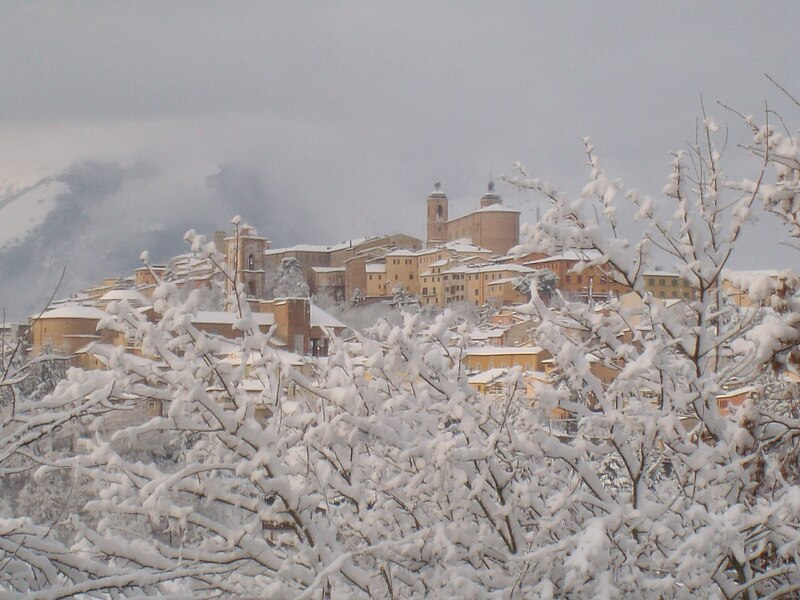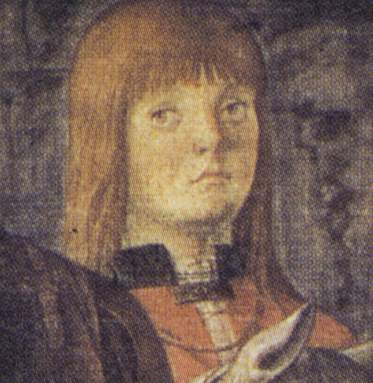 |
| Camerino |
Mopping Up
On 8th
July Vitellozzo Vitelli took the Florentine border fortress of Borgo di San Sepulcro for Cesare and on 20th Cesare took Camerino.
‘At about three o’clock on
Saturday afternoon, July 23rd, the news was brought to the pope that
Don Cesare Borgia had taken over Camerino without any fighting……Don Cesare had
negotiated a peace treaty with the ruler of Camerino for a specific period of
time, but then….had astutely entered and seized the city.’[i]
He took
Varano and his children prisoner.
When Louis
XII arrived in Milan on 28th July he was petitioned by the Duke of
Urbino, the Orsini[ii]
and envoys from the Florentine government, for his help in recovering lands
lost during Cesare’s recent campaigns. Cesare left Urbino on 5th
August, disguised as a Knight of St John, and upon arriving in Milan rekindled his friendship
with Louis. He proffered his support for Louis’ upcoming campaign in Naples in
return for support at Bologna.
 |
| Leonardo da Vinci |
A Genius at Work
On the 18th
August Cesare appointed Leonardo da Vinci[iii] as his architect and military
engineer, ordering him to inspect Cesare’s strongholds and fortresses. He may
have been introduced to Cesare by the Florentines, hoping to insert a spy into
Cesare’s court. They met in late July in Urbino, Leonardo having just finished
a short tour through Cesare’s domains. Cesare promised Leonardo manuscripts;
‘Borges [Cesare] will get me
the Archimedes of the Bishop of Padua[iv],
and Vitellozzo the one at Borgo di San Sepulcro.’[v]
On 5th
September Lucrezia gave birth to a still-born daughter and she was still unwell
when Cesare visited her in Ferrara on 7th, returning from his trip to Milan. Cesare
then returned to Rome after meeting Machiavelli in Imola where he had created
an administrative headquarters. Lucrezia was out of danger by early October when
Rodrigo made the young Giovanni Borgia duke of Camerino as well as of Nepi.
Cesare started
on a reformation of the administration of the Romagna, placing some of his
relatives in holy orders as administrators. He was attempting to create a
government machinery, based in Imola, to replace the capricious rule of the
individual families. One of his first acts was to dismiss Lorqua as his
vicar-general; he was given Rimini to govern. Cesare placed a noted jurist and
humanist Antonio di Monte Sansovino as head of his new administration.
The Great Revolt
| Giovanni II Bentivoglio |
A number of
Cesare’s captains conspired with the disposed lords of the Romagna. They were
worried that Cesare’s ambitions were boundless and plotted to assassinate him. The
conspirators included a number of members of the Orsini family, Giovanni II Bentivoglio Lord of Bologna, , the Lord of Fermo Oliverotto Eufreducci, Pandolfo Petrucci of Siena, the new Lord of Città di Castello Vitellozzo Vitelli and the Lord of Perugia Gianpaolo Baglioni.
The Orsini discovered
that Louis had given permission for Cesare to use them as he wished[vi]. Bentivoglio had received
a summons on 17th September to Rome to answer for his failings as a
papal vicar and on 23rd he was given a direct order by Louis to
surrender Bologna to the pope. The other lords and condottiere also had reason
to hate the Borgia family.
The
conspiracy started with an uprising on 7th October of the town of San Leo, fiercely loyal to the Montefeltro dukes of Urbino. Other towns, mostly
in the south of the Romagna, followed suit including Urbino and Gubbio.
On 9th
October the conspirators met at La Magione where they agreed to launch a two
pronged attack; Vitelli and the Orsini would attack Urbino and Ermes Bentivoglio would attack Imola.
 |
| Rocca di San Leo |
‘Gathering together a force
of about five hundred horses and two thousand infantry, they [the conspirators]
they first restored the City of Urbino….to Don Guidobaldo….They then surrounded
Imola, striking fear into the heart of Don Cesare, and similarly terrifying the
pope, who immediately sought help from the King of France.’[vii]
 |
| Ugo di Moncada |
Realising
that he was over extended Cesare ordered Michelotto and Ugo de Moncada to leave Urbino, which they did reluctantly allowing a
triumphant Guidobaldo Montefeltre to return to his city. Oliverotto Eufreducci
helped the last surviving member of the Varano family retake Camerino.
Fossombrone and Pergola, encouraged by the retaking of Urbino, rose against the
Borgia troops stationed in their towns and slaughtered the mainly Spanish
garrison. Michelotto and Moncada who were en route to Imola, ignored their
orders and their Spanish troops reduced the two towns to smouldering rubble on
11th October.
The Orsini,
Vitelli and Baglioni joined forces and trounced Cesare’s troops at Fossombrone.
Moncada was taken prisoner but Michelotto managed to escape, while the remnants
of their army were driven down the coast, and Cesare was surrounded at Imola.
Turning the Tables
 |
| Imola cathedral |
Cesare had
been well aware of the negotiations of his condottiere with the rebellious
lords of the Romagna. Cesare also had a Florentine observer with him;
Machiavelli was still in Imola. In addition Cesare had Louis’ support as he
informed Machiavelli;
‘Imagine what I can get to
defend myself from those men, the greater part of whom His Majesty the King
believes are his violent enemies….the Vitelli cannot reveal themselves at an
hour when it will damage me less.’[viii]
Machiavelli
assured Cesare that he knew that Cesare would be victorious against his
enemies. He had not only Louis’ support but also that of his father; Cesare had
access to papal funds and he used these to pay the soldiers he was sending to
key fortresses and cities. Cesare was aware that Venice had refused to assist
the conspirators and he also knew that Florence could not afford to support
them either.
The
conspirators also lacked one essential for success, a man with the ability to
keep these disparate allies working together. Cesare played divide and rule
with his adversaries; one by one the conspirators came to terms with Cesare;
Machiavelli informed Florence that a disguised Paolo Orsini visited Cesare in
Cesena, on the evening of 24th October. Cesare informed Paolo that
he must have Urbino and Camerino returned to his control; a message that was
not received with equanimity by the conspirators when Paolo returned to Magione.
 |
| Pandolfo Petrucci |
Rodrigo also
spent time working on turning the conspirators. His attempts were centred on
Cardinal Orsini
‘Cardinal Orsini was rash
enough not to consolidate his own power and that of his family after the
settlement with the Borgias in November. He refused to listen to anyone, but
often remarked with a smile that he had never had any difference with the pope.
He imagined that by securing peace he could profit from it.’[ix]
Pandolfo
Petrucci contacted Cesare; assuring him, in a craven epistle, that he had never
intended to displease him. Cesare’s disloyal captains were forgiven but they
had to give him a son each as hostages to fortune. Machiavelli was sceptical of
Cesare’s seeming benevolence towards his captains.
Countering the Conspiracy
 |
| Ermes Bentivoglio |
Mid-November
saw Rodrigo using the death of the Bishop of Cortona to replenish the papal coffers,
seizing the bishop’s goods and selling the diocese to a Florentine for 2,000
ducats[x]. Rodrigo sent 15,000
ducats[xi] worth of coins to Cesare
on 3rd December; the army was costing 2,000 ducats a day to keep on
the road.
When Cesare
failed to make any response to Ermes Bentivoglio’s dispositions outside Imola,
Ermes withdrew in confusion. On the 9th December Rodrigo was
informed that Cesare had retaken Urbino;
‘The pope heard news of the
recapture of Urbino with all its possessions by Don Cesare Borgia, who had
reached a satisfactory settlement with Don Guidobaldo whereby the latter was
allowed to leave the city in safety with all his wealth and goods.’[xii]
 |
| Porta Malatesta Camerino |
Two weeks
later Rodrigo was told of the recapture of Camerino and on Christmas Day the
head of the hated Lorqua was found impaled on a spear in the central square in
Cesena. He’d arrived three days previously from Rimini and been arrested on his
arrival and was then interrogated. Lorqua’s brutality was well-known and he had
been brutalising his new subjects in Rimini, a state of affairs that Cesare
clearly did not wish to continue.
The remaining
conspirators were won over by Louis’ intervention; Bologna was joined with
Florence under French protection and made off limits to Cesare. Giovanni II
Bentivoglio was forced to pay Cesare a substantial amount of gold and provide
him with troops.
 |
| Andrea Doria |
On 30th
December Senigallia surrendered to Cesare’s troops.
Giovanna da Montefeltro[xiii] fled the town with two
barges filled with her possessions and sailed to Venice with her son, leaving
the keys in a silver basin to be handed to Cesare. The fortress was surrendered
to Cesare by Andrea Doria[xiv]. The following day Cesare himself arrived at
Senigallia and was greeted by Vitelli, Euffreducci, and Paolo and Francesco
Orsini. Once inside the gates the four were arrested by Cesare’s men.
Bibliography
At the Court
of the Borgia – Johan Burchard, Folio Society 1990
Lucrezia
Borgia – Rachel Erlanger, Michael Joseph 1979
Florence and
the Medici – JR Hale, Phoenix Press 2001
The Rise and
Fall of the House of Medici – Christopher Hibbert, Folio Society 2001
The Borgias
– Mary Hollingsworth, Quercus Editions 2014
The Borgias
– GJ Meyer, Bantam 2013
Leonardo da
Vinci – Charles Nicholl, Penguin Books 2005
A History of
Venice – John Julius Norwich, Penguin Books 1982
Absolute
Monarchs – John Julius Norwich, Random House 2011
The March of
Folly – Barbara Tuchman, Cardinal 1990
Niccolo’s
Smile – Maurizio Viroli, IB Tauris & Company Ltd 2001
www.wikipedia.en
[i]
At the Court of the Borgia - Burchard
[ii]
Who had lost much in the way of lands when Cesare cut his swathe through the
Romagna
[iii]
Leonardo had been working for Ludvico Sforza and had lost his job when Louis
took Milan
[iv]
Pietro Barozzi, Bishop of Padua 1487 - 1507
[v]
Leonardo da Vinci - Nicholl
[vi]
The source may have been Rodrigo who was becoming garrulous in his old age and
was often unaware of what he had let slip
[vii]
At the Court of the Borgia - Burchard
[viii]
Niccolo’s Smile - Viroli
[ix]
At the Court of the Borgia - Burchard
[x]
In 2013
the relative:historic standard of living
value of that income or wealth is £1,216,000.00 economic status value of that income or wealth is £37,680,000.00 economic power value of that income or wealth is £527,100,000.00 www.measuringworth.com
[xi]
In 2013
the relative: historic standard of living
value of that income or wealth is £9,120,000.00 economic status value of that income or wealth is £282,600,000.00 economic power value of that income or wealth is £3,953,000,000.00 www.measuringworth.com
[xii]
At the Court of the Borgia - Burchard
[xiv]
Genoese Admiral and condottiere
No comments:
Post a Comment
Note: only a member of this blog may post a comment.